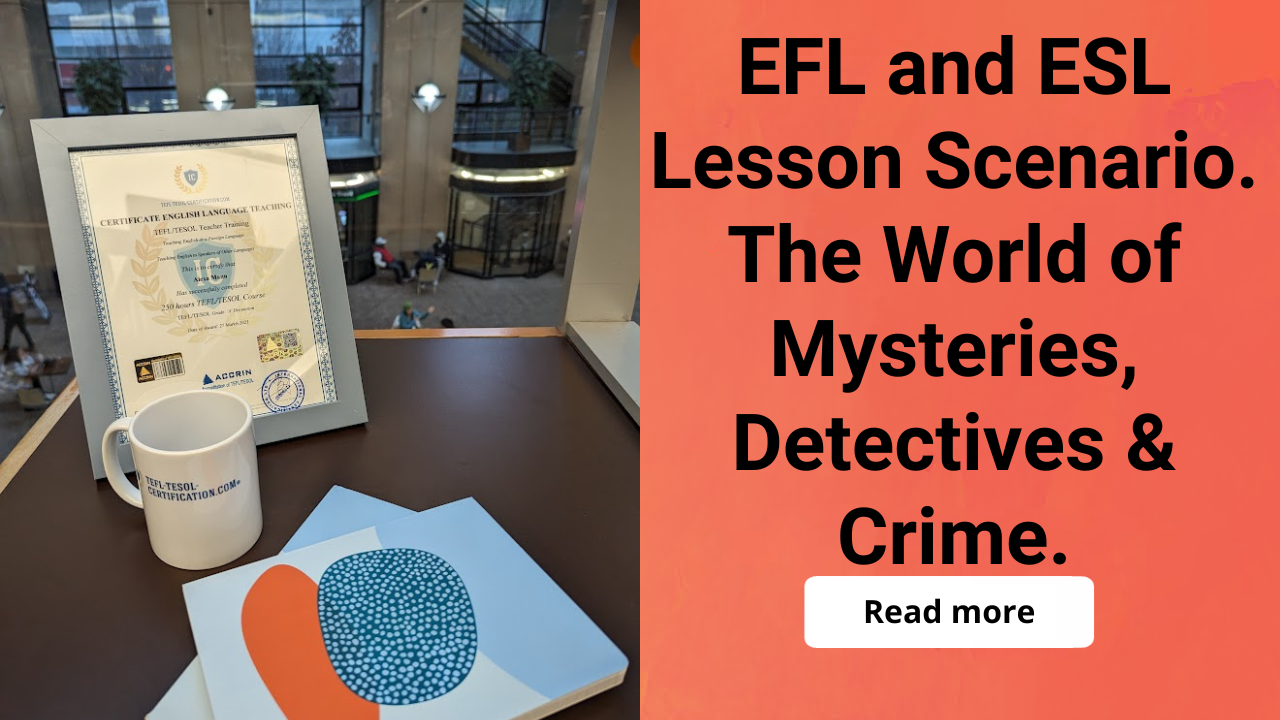And start earning money 💸 by teaching English in your own country, abroad, or online from anywhere on the planet! 🎁 Gifts and bonuses: professional support from your personal coach 🧑🏫 and job placement assistant 💼.

EFL and ESL Lesson Scenario. The World of Mysteries, Detectives & Crime.
Table of contents
In the ever-evolving landscape of English language education, integrating real-world themes into the curriculum has proven to be an invaluable strategy for fostering engagement, critical thinking, and language acquisition among learners. One theme that stands out for its universal relevance and multidisciplinary connections is the topic of crime. Covering crime in English lessons goes beyond mere sensationalism or the intrigue of detective stories; it opens up a rich vein of vocabulary, ethical discussions, and cultural insights that can significantly enhance students' learning experiences.
The importance of incorporating the crime topic into English lessons cannot be overstated. First and foremost, crime-related content captivates students' interest, drawing them into complex narratives that require careful listening, reading, and interpretive skills. Through the lens of crime, students are exposed to a specialized vocabulary ranging from legal terms to colloquial expressions, providing them with a more comprehensive command of the English language. Moreover, discussing crime and justice issues offers a platform for students to practice articulating opinions, formulating arguments, and engaging in debates, thereby improving their speaking and critical thinking abilities.
Furthermore, crime stories, whether real or fictional, serve as mirrors reflecting societal values, challenges, and the multifaceted nature of human behavior. By analyzing these narratives, students gain insights into different cultures and legal systems, fostering a global perspective and empathy. This not only aids in their language development but also prepares them for real-world interactions in an increasingly interconnected world.
In essence, the topic of crime in English lessons is a gateway to not only linguistic Prociency but also to a deeper understanding of the world. Through engaging with this theme, students develop not just as language learners, but as informed global citizens equipped to navigate the complexities of contemporary society.
Creating an English lesson plan centered around the theme of crime can engage students with exciting activities, critical thinking, and new vocabulary. Here are various activities, vocabulary, scenarios, and a detective story segment to help students immerse themselves in the topic.
Level: Upper-Intermediate to Advanced
Warm-up questions
Warm-up questions are a great way to kick off a lesson on the crime genre, stirring curiosity and personal engagement among students. Here are some thought-provoking questions that can help set the stage for a lively discussion or lesson on crime and detective fiction.
To enhance engagement and add an element of surprise to your lesson, consider preparing slips of paper with the questions written on them. Place these slips into a hat or a box. Then, invite students to draw a question at random and share their answer with the class. This method not only makes the activity more interactive but also ensures that each student has an equal opportunity to participate and contribute to the discussion. The unpredictability of the question selection adds excitement and can lead to a more dynamic and inclusive classroom atmosphere.
- Who enjoys reading detective fiction? Can you share the title of the last detective book you read?
- Do you have a favorite writer in the crime or detective genre? What do you like about their writing?
- Who likes to watch detective TV shows or crime dramas? What is your favorite, and why?
- Have you ever read a crime story that you found too scary or intense? What was it about?
- In your opinion, what makes a good mystery or detective story?
- Do you prefer historical mysteries or contemporary crime stories? Can you explain your preference?
- Who is your favorite fictional detective, and what do you find most appealing about this character?
- Have you ever solved a mystery in a book or show before the characters did? How did you figure it out?
- Do you think true crime stories are more interesting than fictional ones? Why or why not?
- If you could write your own crime story, what would it be about?
- What is the most memorable plot twist you’ve encountered in a crime story?
- Do you enjoy puzzle-solving or mystery games? Can you share a favorite?
- Have any of you ever attended a murder mystery dinner or event? What was the experience like?
- In detective stories, do you prefer the focus to be on the detective’s process or the criminal’s psychology? Why?
- What do you think is the most important element in a crime story: the characters, the plot, or the setting?
- Who has played the board game Clue (or Cluedo, depending on the region)? What do you enjoy most about it?
- Can you recall a time when you solved the mystery in Clue? Who was the culprit, and with what weapon?
- Have you ever participated in a detective quest or an escape room with a mystery or crime theme? What was the story?
- Do you enjoy playing detective or mystery-themed board games? Can you name a few of your favorites?
- How do board games like Clue help you think like a detective? Do you use any specific strategies?
- Have you ever designed your own mystery or crime game, even if just in theory? What was the concept?
- In detective board games or quests, do you prefer to work alone or as part of a team? Why?
- Are there any mobile apps or video games with a detective theme that you enjoy playing? What makes them engaging?
- How do you think playing detective games helps with your problem-solving skills in real life?
- If you could create a detective board game, what unique twist would you add to make it stand out?
- Do you think detective games are more fun when they are more realistic or more fantastical? Why?
- What is the most difficult mystery you’ve ever solved in a game? What made it challenging?
- Have you learned any interesting facts about crime investigation or forensics from playing detective games?
- Do you prefer games where you solve a mystery once, or ones that can be played multiple times with different outcomes?
- If you were to host a murder mystery party, what setting or theme would you choose?
These questions are designed to delve into students' interactive and gaming experiences related to the crime genre, encouraging them to share and reflect on how these activities complement their understanding and enjoyment of mystery and detective stories.
Vocabulary activity
For a more immersive vocabulary activity that moves beyond the traditional matching game, consider introducing a short detective story accompanied by a set of questions. This approach allows students to actively engage with the narrative, connecting characters and their actions directly to the crime-related vocabulary presented in the story. As students delve into the plot, they will be tasked with identifying specific terms and phrases that correspond with the story's events, effectively matching the crime vocabulary to its contextual use. This method not only enhances vocabulary acquisition but also encourages critical thinking and comprehension skills, as students must understand both the story's details and the vocabulary's application within it. It's an interactive way to deepen their understanding of the language and its nuances, making the learning process both effective and enjoyable.
Here is an example.
Detective Story: The Mystery of the Vanished Necklace
In the quiet town of Elmwood, the unexpected happened at the grand estate of Mrs. Eleanor Grayson, a wealthy widow known for her exquisite collection of jewels. The most prized piece, the Midnight Sapphire Necklace, vanished during her annual summer gala. The disappearance of the necklace sent shockwaves through the community, turning the gala into a crime scene.
Detective Anna Lynch was assigned to the case. Her reputation for meticulous attention to detail and unwavering determination made her the perfect candidate to unravel this mystery. Upon arrival, Detective Lynch began her investigation by interviewing witnesses. The butler, Mr. Collins, claimed to have seen a shadowy figure near the display room, but his vague description wasn't enough to identify a suspect.
The list of suspects included:
Charles Beaumont, Mrs. Grayson's nephew, known for his extravagant lifestyle and mounting debts.
Sophia Langley, a close friend of Mrs. Grayson, who was the last to leave the gala.
Liam Caldwell, a renowned jeweler who had recently appraised the necklace.
Detective Lynch meticulously examined the crime scene for evidence. A hidden camera in the corner of the room revealed the silhouette of a person tampering with the necklace display. However, the footage was too grainy to identify the face. Lynch noticed a unique cufflink near the display case, which became a crucial piece of evidence.
Further investigation led Lynch to discover that the cufflink belonged to Charles Beaumont. When confronted, Charles admitted to taking the necklace to pay off his debts, believing he could return it before anyone noticed. His plan, however, had failed miserably.
Charles was arrested and charged with theft. The case was handed over to the prosecutor, Mr. Jameson, who was known for his strict adherence to justice. The evidence against Charles was overwhelming, and he was sentenced to community service and restitution, including the return of the necklace and a public apology to Mrs. Grayson.
Detective Lynch's ability to piece together the clues and evidence had once again solved a seemingly unsolvable case. The town of Elmwood could rest easy, knowing the mystery of the vanished necklace was no longer a mystery, thanks to Detective Lynch's dedication.
Questions for Vocabulary Matching and Comprehension:
- Who is the suspect? (Match with "Charles Beaumont")
- What is the crime? (Match with "Theft")
- What is the punishment for the crime? (Match with "Community service and restitution")
- Who is the prosecutor in this story? (Match with "Mr. Jameson")
- What piece of evidence was crucial in solving the case? (Match with "A unique cufflink")
- What role did Detective Lynch play in the story? (Match with "Investigator of the case")
- Who was the victim of the crime? (Match with "Mrs. Eleanor Grayson")
- What was stolen? (Match with "The Midnight Sapphire Necklace")
- What mistake did the suspect make? (Discuss Charles Beaumont's plan and failure)
- How was the suspect related to the victim? (Match with "Nephew")
Role-Play Activities
Role-play activities are an essential component of modern English lessons, offering students a dynamic and immersive way to experience the language in contexts that closely mimic real-life situations. These activities empower students to apply their language skills in a variety of scenarios, preparing them for the nuances and challenges of real-world communication. Through role-play, learners can experiment with vocabulary, grammar, and expressions in a safe and supportive environment, enabling them to build confidence and fluency. Furthermore, by stepping into different roles and perspectives, students enhance their cultural awareness and empathy, skills that are invaluable in our increasingly globalized world. Incorporating role-play into English lessons not only facilitates a deeper understanding of the language but also equips students with the practical communication tools they need to navigate diverse settings and interactions successfully.
- Divide the class into small groups and give each group a scenario card related to a crime (e.g., a theft in a museum, a mysterious disappearance, etc.).
- Each group creates a mini-drama based on their scenario, assigning roles such as detective, suspect(s), and witness(es).
- Encourage them to use as much of the crime-related vocabulary as possible.
- Groups perform their mini-dramas for the class.
Creating engaging and thought-provoking scenarios for your classroom activity can make the learning experience both educational and entertaining. Here are three examples of crime scenarios that students can use to craft their mini-dramas:
Scenario 1: The Case of the Vanished Heirloom
Background: During a lavish family reunion at an old, sprawling estate, a precious heirloom – a diamond brooch passed down through generations – goes missing. The family matriarch is distraught, and rumors quickly spread among the guests.
Roles:
Detective: Hired to discretely investigate the disappearance without alarming the guests.
Suspect 1 - The Jealous Cousin: Known for their envy of the family's wealth and particularly interested in the brooch.
Suspect 2 - The Forgetful Uncle: Last seen near the brooch's display case, notorious for his absent-mindedness.
Witness - The Loyal Butler: Claims to have seen a shadowy figure lurking in the hallways.
Objective: Uncover the truth behind the brooch's disappearance, using clues and interrogating the suspects.
Scenario 2: The Mystery of the Locked Library
Background: A renowned author is found unconscious in a locked library, with the only copy of their unpublished manuscript missing. The door was locked from the inside, and there are no clear signs of forced entry or struggle.
Roles:
Detective: Tasked with solving the perplexing mystery of how the manuscript was stolen and who would benefit from its theft.
Suspect 1 - The Rival Author: Known to have a contentious relationship with the victim and to covet their success.
Suspect 2 - The Ambitious Assistant: Has access to the library and desperately wants to become an author.
Witness - The Housekeeper: Noticed unusual behavior in the house leading up to the event.
Objective: Figure out how the manuscript was stolen and identify the culprit among the suspects.
Scenario 3: The Art Gallery Intrigue
Background: At the grand opening of a prestigious art gallery, a valuable painting disappears while the lights mysteriously go out for a brief moment. Security cameras fail to capture the theft, leaving everyone baffled.
Roles:
Detective: Brought in to solve this high-Prole case with minimal evidence.
Suspect 1 - The Disgruntled Artist: Whose work was not featured in the gallery and was seen arguing with the curator.
Suspect 2 - The Tech-Savvy Teen: Known for hanging around the gallery and showing an unusual interest in the security system.
Witness - The Security Guard: Claims to have seen someone near the painting just before the lights went out.
Objective: Discover how the painting was stolen and who is responsible for the art gallery intrigue.
Each scenario encourages students to dive into their roles, think creatively, and use crime-related vocabulary to develop their storylines. By acting out their mini-dramas, students not only practice language skills but also develop teamwork and problem-solving abilities.
💡 Unlock the secrets to doubling your teaching income with our exclusive checklist! 🎯 This checklist is designed for English teachers who want to 📈 attract more students and 🔥 keep them engaged for the long term.
Discussing video clips
Discussing a video clip provides an excellent opportunity to see English in action in a unique setting, enhancing students' comprehension skills and expanding their vocabulary. It also offers a chance to observe cultural nuances and investigative techniques that vary from one story to another. After viewing, conduct a group discussion to share observations and thoughts on the clip's development, focusing on the crucial role language plays in storytelling, especially within the crime genre.
When selecting a YouTube clip from a detective show for classroom use, it's important to choose content that is engaging, appropriate, and rich in educational value. Here are a few ideas for clips, along with types of questions that could accompany each to stimulate student involvement and comprehension:
1. Sherlock (BBC): "A Study in Pink"
Clip Idea: Select a segment where Sherlock first arrives at the crime scene and begins to deduce key details about the case. Questions:
- What crime is Sherlock investigating?
- List any pieces of evidence Sherlock uses to make his deductions.
- Predict how Sherlock will solve the case based on the initial clues.
- Identify any crime-related vocabulary used in the scene.
2. Agatha Christie's Poirot: "The Adventure of the Clapham Cook"
Clip Idea: Choose a part where Poirot interviews suspects or gathers clues about the missing cook.
Questions:
- What is the mystery Poirot is trying to solve?
- Note the questions Poirot asks the suspects. How do they help him gather clues?
- Based on the information provided, who do you think is involved in the cook's disappearance?
- Identify specific vocabulary related to detective work mentioned in the clip.
3. Miss Marple: "The Murder at the Vicarage"
Clip Idea: Use a segment where Miss Marple discusses her theories about the murder with the Vicar or the police.
Questions:
- What are Miss Marple's main theories about the murder?
- What evidence does Miss Marple use to support her theories?
- Who are the main suspects, and why?
- Highlight any crime-related vocabulary or idiomatic expressions used in the discussion.
4. Brooklyn Nine-Nine
Clip Idea: Although not a traditional detective show, a scene where Detective Jake Peralta solves a case could be engaging and suitable for students.
Questions:
- Describe the crime being investigated.
- What vocabulary does Detective Jake Peralta use when he lists all the evidences.
- Identify any humorous elements used to approach detective work in this show. Are there any specific terms or vocabulary used that are unique to this series?
Before showing any clip, ensure it aligns with your educational objectives and is appropriate for your students' age group and sensitivity. Discussing the clip afterward provides a valuable opportunity to deepen students' understanding of the English language, especially the specific vocabulary and phrases related to crime and investigation, and to enhance their analytical skills through the context of storytelling.
The Homework Assignment
The homework assignment may involve writing a brief detective story that incorporates the vocabulary and concepts learned in class. Students are encouraged to focus on creating a clear narrative that includes a crime, its investigation, and the resolution. This task allows for the practical application of new language skills, emphasizing the use of crime-related vocabulary and the construction of a coherent and engaging plot. The assignment aims to challenge students to develop vivid descriptions and a storyline that maintains suspense and interest through to its conclusion. It's an opportunity to explore the creative aspects of language learning by crafting a mystery that showcases their understanding of the genre and their ability to captivate readers with their storytelling.
🚀 More students, 💰 higher income, 🌍 complete freedom! ✅ 112 verified platforms with top rates ⏳ Flexible schedule – work whenever and as much as you want 🎯 Simple requirements – start earning right away 💎 Boost your career and income by teaching students worldwide!
Conclusion
In conclusion, this lesson activities on the crime genre offer a multifaceted approach to learning English, blending the excitement of detective stories with the rigors of language acquisition. Through activities like vocabulary brainstorming, reading detective stories, role-playing, video clip analysis, and creative writing, students are immersed in a world that not only enhances their language skills but also sharpens their analytical thinking and creativity. The incorporation of crime-related vocabulary, coupled with the exploration of narrative structures and character development, provides learners with a comprehensive understanding of both the language and the genre. As students engage with the material, they not only expand their linguistic capabilities but also develop a deeper appreciation for the storytelling elements that make the crime genre so captivating. This lesson plan is designed to inspire curiosity, foster engagement, and encourage a deeper connection with the English language, preparing students not only to be Procient speakers but also critical thinkers and creative storytellers.

York Fern
An English instructor with 12+ years of experience. I work for an online school and travel the world, teaching students from various countries, leveraging my TEFL/TESOL certification. Seeing the world's oceans, mountains, and cities with my own eyes has given me a profound appreciation for the importance of quality education and international communication.
and start earning by teaching English in your country, abroad, or online from anywhere in the world! Order the course with a 50% discount 💸 and receive as a gift the support of a personal coach 👨🏫 and job placement assistant! 🎁🚀 Hurry, limited spots available! 🏃♂️💨
💡 Unlock the secrets to doubling your teaching income with our exclusive checklist! 🎯 This checklist is designed for English teachers who want to 📈 attract more students and 🔥 keep them engaged for the long term.
🚀 More students, 💰 higher income, 🌍 complete freedom! ✅ 112 verified platforms with top rates ⏳ Flexible schedule – work whenever and as much as you want 🎯 Simple requirements – start earning right away 💎 Boost your career and income by teaching students worldwide!
choose us?



